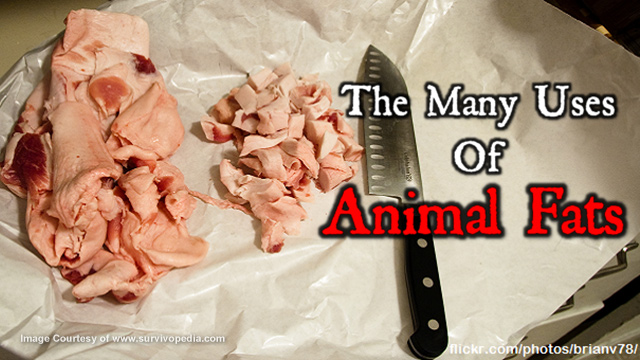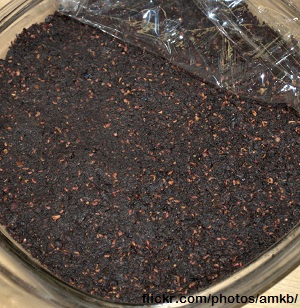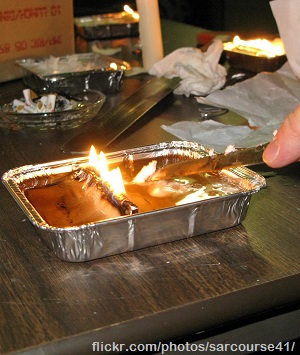The many uses of animal fats
Saturday, April 04, 2015 by: Natural News Editors
Tags: animal fat, candle making, soap making

- High-dose vitamin C injections shown to annihilate cancer
- Eight nutritional supplements you should be taking
- The REAL FAKE NEWS exposed: '97% of scientists agree on climate change' is an engineered hoax... here's what the media never told you
- Four reasons to love coconut oil
- Six little-known natural remedies for tinnitus
- The best and worst forms of magnesium to take as a supplement
- Study confirms that fluoride causes weight gain and depression
- Total corruption: Drug companies bought their way onto FDA advisory panels
- Ginger tea shown to naturally kill cancer, dissolve kidney stones, improve liver health and more
- How can CoQ10 make it easier to quit cigarettes?
- What parents need to know about Monsanto: "By 2025 one in two children will be autistic"
- Consolidation of seed companies leading to corporate domination of world food supply
- Four easy ways to improve your thyroid function
- Apricot Seeds Kill Cancer Cells without Side Effects
- Superfood Profile: Discover the Health Benefits of Bee Pollen
- The beginning of the end for glyphosate?
- Genital Herpes May be Reversed with Natural Medicine
- Vaccines cause autism: Supporting evidence
- Six little-known natural remedies for tinnitus
- High-dose vitamin C injections shown to annihilate cancer
- Olive oil antioxidant naturally kills all cancer cells tested within an hour
- Four bitter herbs heal the liver, gall bladder, and other ailments
- Dandelion root far more effective in fighting cancer cells than chemotherapy
- Eight nutritional supplements you should be taking
- Research: Effective psychotherapy proven to positively alter your physical brain (no drugs required)
- Foods that detox heavy metals - with tonic recipe
- 'Miracle cure' controversy and why people should use DMSO for cancer, inflammation and more
- The best and worst forms of magnesium to take as a supplement
- Curcumin causes colon cancer cells to self-destruct
- 10 outrageous (but true) facts about vaccines the CDC and the vaccine industry don't want you to know
- Cancer cases projected to skyrocket to one in two men in the future: How will you prevent it?
- When MEDICINE becomes MURDER: America's vaccine narrative now mirrors Nazi eugenics propaganda
- Artemisinin: A Cancer Smart Bomb
- Man's best friend can save your life from cancer! Dogs detect cancer with 90 percent accuracy
- Grow the ultimate survival garden by investing in these healing herbs that function as natural medicine
- Vitamin B-12 warning: Avoid cyanocobalamin, take only methylcobalamin
- Six little-known natural remedies for tinnitus
- Supplements to detox the body from vaccinations
- High-dose vitamin C injections shown to annihilate cancer
- The REAL FAKE NEWS exposed: '97% of scientists agree on climate change' is an engineered hoax... here's what the media never told you
- The 10 worst toxins hidden in vitamins, supplements and health foods
- Beat cancer with 35% hydrogen peroxide
- Olive oil antioxidant naturally kills all cancer cells tested within an hour
- Curcumin causes colon cancer cells to self-destruct
- Curcumin slays cancer cells in their tracks
- Four bitter herbs heal the liver, gall bladder, and other ailments
- Cannabis kicks Lyme disease to the curb
- Foods, herbs, and supplements that kill cancer - safer and more effective than drugs
- Top 10 inexpensive food items that can PREVENT nearly every disease and disorder known to mankind
- Frankincense oil kills cancer cells while boosting the immune system, studies show
- Foods that detox heavy metals - with tonic recipe
- The aloe vera miracle: A natural medicine for cancer, cholesterol, diabetes, inflammation, IBS, and other health conditions
- Vitamin B-12 warning: Avoid cyanocobalamin, take only methylcobalamin
- Forget Filling Cavities: Regrow Your Teeth Instead
- EPA advisor admits the agency is funneling billions to climate groups ahead of Trump’s return to White House
- Newly released JFK files reveal Pentagon's role in creating Lyme disease and covid in the same lab
- Eleven days before Iran bombed Tel Aviv, my microscope revealed haunting images of EXACTLY what would happen
- Morphic resonance “remote viewing” reveals iconic Middle East images of stealth bombers, a falcon and a one-horned ram
- Mike Adams releases country western hit single: Goin’ Back in Time is Comin’ Home
- DECENTRALIZED SPIRITUALITY and the true teachings of Christ: Overcoming the censorship, threats and lies of organized religion to truly know God and the Universal Christ
- Global leaders unite to clamp down on “misinformation” with UN-backed Cascais Declaration
- I Want My Bailout Money – new song released by Mike Adams
- HEALTH SECRETS: How to Instantly Block MSG Toxicity Using Natural Substances (and the secret of Methylene Blue)
- The Health Ranger releases “Vaccine Zombie” song and music video, using AI-animated zombies for the music video
- BOMBSHELL: Internal Pfizer documents exposed and reveal at least 16 PERCENT of their mRNA vaccine "adverse events" are REPRODUCTIVE DISORDERS
- BOMBSHELL: Covid-19 mRNA nanoparticles EMIT LIGHT SIGNALS that communicate MAC addresses used for self-assembly inside the blood vessels
- Two containers with completed ballots fall out of truck in Florida
- BOMBSHELL: DNA testing kits are a SCAM to develop ethnic-specific bioweapons
- Amazing microscopy photos reveal how freezing crystals attempt to mimic electronic structures they are touching
- RFK Jr. clears key hurdle: Sen. Susan Collins backs controversial HHS nominee, signaling a new era for health policy
- The Coming Gold Revaluation: Strategic Financial Realignment in an Era of Dollar Collapse
- The AI Data Center Wars Have Begun… Farms, Water and Electricity is Stripped from Humans to Power the Machines
If you're prepping, knowing which fats are best for certain projects will give you even more tools to work with when you may need them.
Different animals yield different fat with different textures, melting points and flavors, and thus different uses. Also, some animals carry much more fat than others, so if you're hunting during a time that you need a lot of fat, you may be able to target higher-fat animals versus their slimmer counterparts.
Today we're going to touch on a few different projects and match you up with animals that provide good fat for your needs.
Rendering the Fat
Before you use any fat, you need to render it. Rendering is simply the process of heating the fat in order to separate the liquids from the solids so that you have a usable product that isn't going to go rancid as quickly as unrendered fat.
The rendering process is pretty easy: Make sure that ALL of the meat is removed from the fat, then cut the fat into very small pieces and add it to a skillet or pot over low heat. If you're working with hard fats such as the fat found in large farm and game mammals, it's easiest to get the fat really cold and use your cheese grater. You'll save yourself a ton of time by doing this because large chunks of fat can take days to melt. Softer fats such as goat fat and fowl game fat can just be cut into small pieces with a knife.
Next, you can choose to dry render, semi-wet render or wet render your fat. The only difference is that dry rendering uses no water, semi-wet rendering uses only an inch or so of water in the bottom of the pot, and wet rendering uses about equal parts of water and fat. Either way, you need to make sure that all of the water is removed by the end of the rendering process or your fat will spoil faster.
You don't want to actually COOK the fat; you just want to get it hot enough to melt. Cooking it on higher heats may cause it to burn (which ruins it) and can make for stronger-flavored fat. Let it melt down until most of the fat is melted and you no longer see little bubbles rising from the bottom -- this is moisture evaporating and you want ALL of the water out of it. You'll have some little chunks of fat and some cracklings left but when you hit this point, you're done. Remove it from the heat immediately, strain all of the chunks from the fat and you're finished!
Making Schmaltz
Schmaltz is a Jewish delicacy that simply consists of adding onions to your chicken fat during the rendering process. It's used in a wide variety of dishes to add richness and flavor. Though I've never used it, it actually makes me curious to try a variety of herbs during the rendering process to make flavored fats. Hmm. A project for next time, maybe!
Just a side note for rendering fat from fowl: toss the skin in along with the fat because there's a nice layer of fat in it that you just can't trim off. The skin will just crisp up and you can toss it or eat it if you'd like -- it's delicious. It's not exactly healthy now, but if you're in a survival situation, fat is a good source of calories.
Pastries
A solid fat makes for a crisp, flaky pastry but you want to be careful which type you use if flavor matters. Some gamier fats such as bear may add a meaty or gamey flavor to your crust which may be fine if you're making a savory meat pie. Not so much if you're making an apple pie. Visceral fats from any animal, the deep fats found around the organs, may best be rendered separately because it typically has very little flavor and is great for pastries. Beef fat, pork fat and goat fat are also great for sweet pastries.
Savory Recipes
If you're using fat to add flavor and richness, stick with the fat that's the closest to what you're cooking. If you're making a beef stew, break out the tallow. If you're making chicken soup, toss in some schmaltz. That stuff is like crack in any dish that you want to add poultry flavor to!
Pemmican

This is an old Native American food that is packed with fat, carbs and nutrients. It's made from three primary ingredients and is a prepper's superfood because it's easy to transport, it keeps without refrigeration and you can quite literally live off of it if need be. It has fat (typically deer fat but any will do), jerky made from lean meat, and dried fruits and/or berries. You just ball up the ingredients in equal parts and tuck it away.
Deep Frying
When you're choosing a fat to deep fry with, you need to consider two things: taste and smoking point. You don't want to use fats that smoke at lower temperatures. Fats such as butter or bacon grease make them poor choices for deep frying because they smoke at low temperatures. Duck fat is considered a delicacy for frying; you haven't HAD fried potatoes until you've had them fried in duck fat! Other more available fats such as lard, tallow, goat and venison all make good frying grease. Animal fat is typically going to have a lower smoke point than most vegetable oils, just FYI.
Waterproofing
I've tried several different fats for waterproofing[1] and though all of them work, bear grease is by far the best waterproofer that I've found. I'm not sure what the difference is but it just seems to provide better waterproofing, especially for my boots, and it seems to last longer, too.
Fire Starter
Though animal fat goes rancid fairly quickly if not refrigerated, it's still safe to eat but it tastes like crap. If you have fat that's gone rancid but you don't want to waste it, use it to make fire starters.[2] Dip a tampon, a cotton ball or a piece of tinder in the fat and watch it burn!
Soap Making
Animal fat gives you a good, hard bar of soap that won't turn to glop as soon as it gets wet. Tallow (beef fat), goat fat or lard (pig fat) are often used by experienced soap makers. There's no reason why elk, moose or other large animals couldn't be used; these three fats are just more readily-available. You can use fats from some plants but the curing process takes months to years whereas soap made with animal fat is ready to use in about 3 weeks.
Candle Making
You can use animal fat to make simple, functional candles. They won't smell pretty but they'll keep the lights on! Tallow is good for this because it gets good and hard. Lard works but it's a lot softer.

Just place the wick in a jar (I like small jelly jars but use whatever size you want) so that it goes all the way to the bottom, then pour melted tallow in. You'll need to secure the wick so that it stays in the middle until the tallow gets hard. I use a clothes pin but feel free to use whatever you'd like.
Skin Care
The lipids found in mammal fats closely mimic the oils in our skin and people who are getting back to the "old" way of doing things are discovering that animal fats make a great base for soaps, lotions and balms for that very reason. They're easily absorbed and free of the chemicals and toxins found in commercial products. They also make your skin soft and your hair shiny, though be careful using it on your hair; you'll have to wash it a few times to get the grease out.
As you can see, throwing away the fat from any animal is a shame and a waste. There are a multitude of uses for fat and it's a valuable resource that you need to learn how to work with in case SHTF. Fat can literally keep you fed, warm and dry while providing you with light. Don't miss out on it!
If you can think of other uses of fat, please feel free to share them with us in the comments section below!
Read more at Survivopedia.com.
Sources:
[1] http://www.survivopedia.com
[2] http://www.survivopedia.com
Animal fat at FETCH.news
Get independent news alerts on natural cures, food lab tests, cannabis medicine, science, robotics, drones, privacy and more.
Take Action: Support Natural News by linking to this article from your website
Permalink to this article:
Embed article link: (copy HTML code below):
Reprinting this article:
Non-commercial use OK, cite NaturalNews.com with clickable link.
Follow Natural News on Facebook, Twitter, Google Plus, and Pinterest
Science News & Studies
Medicine News and Information
Food News & Studies
Health News & Studies
Herbs News & Information
Pollution News & Studies
Cancer News & Studies
Climate News & Studies
Survival News & Information
Gear News & Information
News covering technology, stocks, hackers, and more



"Big Tech and mainstream media are constantly trying to silence the independent voices that dare to bring you the truth about toxic food ingredients, dangerous medications and the failed, fraudulent science of the profit-driven medical establishment.
Email is one of the best ways to make sure you stay informed, without the censorship of the tech giants (Google, Apple, Facebook, Twitter, YouTube, etc.). Stay informed and you'll even likely learn information that may help save your own life."
–The Health Ranger, Mike Adams























